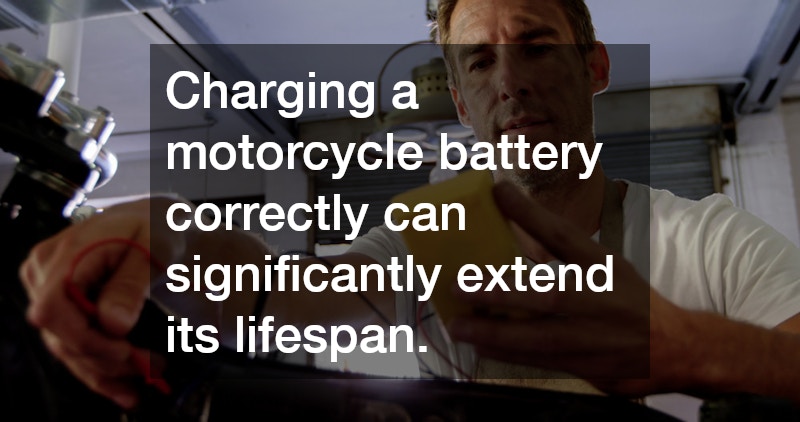What You Should Know Before Choosing a Motorcycle Battery

Choosing the right motorcycle battery is crucial for both performance and safety. A battery that doesn’t suit your motorcycle can lead to a myriad of problems, including poor starts and reduced efficiency. The right motorcycle battery enhances the overall performance of the motorcycle.
It ensures that all electrical components work seamlessly, reducing the chance of a sudden breakdown. Moreover, an appropriate battery minimizes maintenance requirements and prolongs the lifespan of your motorcycle. Therefore, it is important to understand the different types of batteries and how to choose one.
What Types of Motorcycle Batteries Are Available?
Lead-Acid Batteries
Traditional lead-acid batteries have been in use for decades and are widely available. They offer a reliable, cost-effective solution for many motorcyclists. One advantage of lead-acid batteries is their affordability and ease of replacement. However, they are heavier and require regular maintenance, such as checking fluid levels. Despite their drawbacks, lead-acid batteries are often preferred for their durability and established technology. They perform well in extreme temperatures, making them suitable for various riding conditions.
Lithium-Ion Batteries
Lithium-ion batteries are a modern alternative, providing lightweight and powerful performance. They’re particularly popular among high-performance motorcycle enthusiasts. These batteries charge faster and last longer compared to lead-acid types, which can make them a cost-effective choice over time. However, their upfront cost is generally higher. While using lithium-ion batteries, motorcyclists should consider the variance in charging requirements. They can be more sensitive to charging methods and require compatible chargers.
How to Determine the Right Battery Size for Your Motorcycle?
Consulting Your Motorcycle’s Manual
Your motorcycle’s manual is an essential resource for finding the recommended battery size and specifications. It provides critical details that ensure compatibility and optimal performance. Ignoring these specifications can result in a battery that doesn’t fit or perform adequately. Hence, always refer to the manufacturer’s guidelines first. Adhering to these specifications prevents potential damage to both the battery and your motorcycle. It saves you from unnecessary expenses and inconvenience later.
Measuring Current Battery Size
Another approach is to measure your current battery to ensure the replacement matches perfectly. This involves noting the physical dimensions and checking the terminal configuration. Your existing battery can serve as a reliable reference for its replacement. Always ensure that you note down the voltage and ampere requirements as well. Matching the size prevents installation issues and guarantees that the electrical system functions correctly. A proper fit ensures secure installation and minimal vibrations during rides.
What Are the Key Features to Look for in a Motorcycle Battery?
Cold Cranking Amps (CCA)
Cold cranking amps (CCA) represent a battery’s ability to start an engine in cold temperatures. Higher CCA ratings indicate better starting power in adverse conditions. Motorcyclists living in colder climates should prioritize a battery with high CCA. This ensures consistent performance and reduces the risk of starting issues on chilly mornings. Conversely, a lower CCA might suffice in moderate climates, allowing for cost savings. However, it’s crucial not to compromise too much on this feature, as it affects overall battery strength.
Battery Life and Warranty
Battery life is a significant factor, as longer-lasting batteries offer better value. A solid warranty further enhances your peace of mind by covering potential early failures. Choosing a battery with a robust warranty reflects confidence in the product’s durability. It offers protection against defects and unexpected problems. Such features ensure the battery remains a reliable power source throughout its lifespan, reducing long-term costs. A reliable battery supports your motorcycling adventures without frequent replacements.
How to Maintain and Extend the Life of Your Motorcycle Battery?
Proper Charging Techniques
Charging a motorcycle battery correctly can significantly extend its lifespan. It’s vital to use a charger that matches the battery type and specifications. Overcharging or using an incompatible charger can cause irreversible damage to the battery. Consistent care in charging practices prevents premature depletion of battery capacity. By monitoring the charging process, you can maintain the battery’s efficiency and reliability. Investing time in understanding proper charging techniques can lead to substantial savings in replacement costs.
Storing the Battery During Off-Season
Proper storage practices during off-seasons are crucial in maintaining battery health. A well-stored battery retains its charge and remains ready for use when the riding season returns. Ideally, the battery should be stored in a cool, dry place and kept on a trickle charger or battery maintainer. This approach prevents the battery from fully discharging and keeps it in optimal condition. Furthermore, cleaning the battery terminals before storage reduces corrosion risks. Proper off-season maintenance preserves the battery’s capacity, sparing you from efficiency loss when you need it most.
Selecting the right motorcycle battery involves understanding the types, sizes, and features critical to performance and reliability. Always refer to your motorcycle’s manual and consider the environment in which you’ll be riding. Emphasize features such as CCA and battery life, while ensuring proper maintenance to extend the battery’s life. A well-chosen battery supports not only your motorcycle but also enhances your overall riding experience. Ultimately, an informed decision helps avoid unnecessary expenses and ensures your motorcycle remains dependable. With the right battery, you can enjoy the thrill of the open road with confidence and safety.



